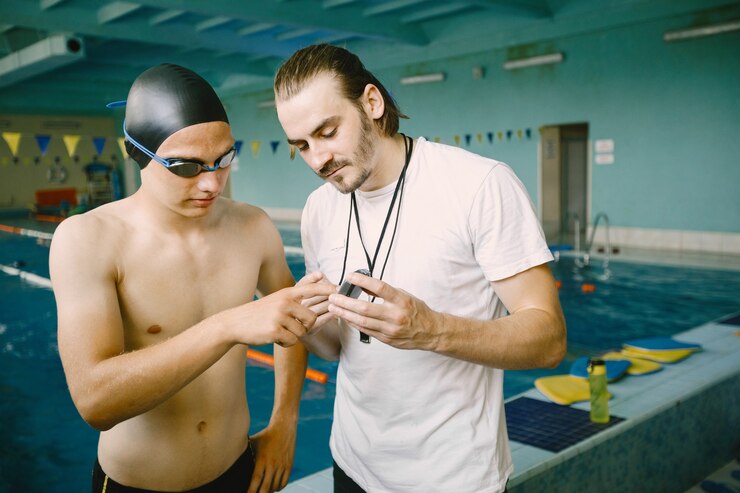Swimming is a fantastic option for rehabilitation after an injury. It’s a low-impact exercise that facilitates gentle movement while promoting healing. However, utilizing proper swimming techniques becomes crucial to maximize recovery and prevent further complications. This guide explores optimal swimming methods to expedite injury healing and confidently get you back in the water.
Streamlining Your Stroke
Effective injury rehabilitation starts with refining your swimming form. Here are key aspects to focus on:
- Body position: Maintain a streamlined body position throughout your strokes. Keep your head aligned with your spine, engage your core, and kick from your hips for maximum propulsion. This minimizes drag and reduces stress on your joints.
- Kicking: Focus on a flutter kick, utilizing small, quick kicks from your hips rather than forceful leg movements. This keeps your body stable and minimizes strain on your lower back.
- Breathing: Breathe rhythmically, turning your head just enough to inhale air without disrupting your body position. Avoid holding your breath, as it can restrict movement and hinder healing.
Targeted Exercises for Specific Injuries
Swimming Exercises for Injury Healing can be tailored to address various injuries. Here are some examples:
- Shoulder Injuries: Focus on drills that isolate your arms, such as sculling and one-arm freestyle. These exercises improve shoulder mobility and range of motion.
- Back Injuries: Choose backstroke drills that emphasize core engagement and a streamlined body position. This will strengthen your core and reduce strain on your back muscles.
- Knee Injuries: For knee injuries, use low-impact exercises like flutter kicking with a kickboard or pool noodles. These exercises strengthen your leg muscles without stressing your knees.
Listen to Your Body and Progress Gradually
Remember, recovery is a journey, not a race. Here are some crucial points to remember:
- Start Slow: Begin with short swim sessions and gradually increase duration and intensity as your body adapts.
- Pain Management: Pay close attention to any pain you experience. Stop the exercise and consult your doctor or physical therapist if you feel discomfort.
- Seek Professional Guidance: Consider working with a physical therapist or swim coach to develop a personalized recovery program that addresses your specific injury.
Safety and Additional Considerations
While swimming is an excellent rehabilitation tool, prioritizing safety is paramount. Here are some additional factors to consider:
- Warm-up and Cool-down: Always dedicate a few minutes to gentle stretches and light swimming before your workout. Similarly, cool down with slow laps and static stretches to promote flexibility and prevent muscle soreness.
- Pool Environment: Ensure the pool is well-maintained and the water temperature is comfortable. A slightly warmer pool can help relax your muscles and improve flexibility.
- Proper Equipment: Use appropriate equipment like a pull buoy or fins to target specific muscle groups or isolate movements during your recovery program.
Conclusion
Swimming is a valuable tool for injury rehabilitation due to its low-impact nature and ability to promote gentle movement. By implementing proper technique, focusing on targeted exercises for your specific injury, and adhering to a gradual progression plan, you can significantly accelerate your recovery and return to enjoying the water. Listening to your body and seeking professional guidance from a doctor or physical therapist is crucial for a safe and successful recovery journey.
FAQs
Can I swim with a recent injury?
Always consult your doctor before starting any exercise program after an injury. They can advise you on the appropriate activities for your specific condition.
How often should I swim for injury recovery?
The frequency of your swims will depend on your injury and overall fitness level. Start with a few sessions per week and gradually increase as tolerated.
Can I swim competitively while recovering from an injury?
Before resuming competitive swimming, consult your doctor or physical therapist. They can advise you on a safe timeline for returning to high-intensity activities.
What are some signs I should stop swimming during recovery?
If you experience persistent pain, swelling, or decreased range of motion, discontinue swimming and consult your healthcare provider.
I’m worried about pool hygiene during injury recovery. Are there any precautions I can take?
Absolutely! Here are some tips to minimize risks associated with pool hygiene:
- Shower before and after swimming: This removes dirt, sweat, and bacteria from your body, helping to maintain pool cleanliness and reducing your exposure to potential pathogens.
- Check the chlorine levels: Inquire about the pool’s chlorine levels. Adequate chlorine ensures proper disinfection and minimizes the risk of bacterial infections.
- Avoid swallowing pool water: While accidental ingestion might happen, try to minimize swallowing pool water.
- Be aware of open wounds: If you have any open wounds, waterproof bandages are recommended to prevent them from coming into contact with pool water.
- Foot hygiene: Wear pool shoes to minimize exposure to bacteria around the pool deck and in locker rooms.



